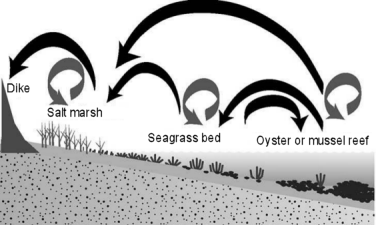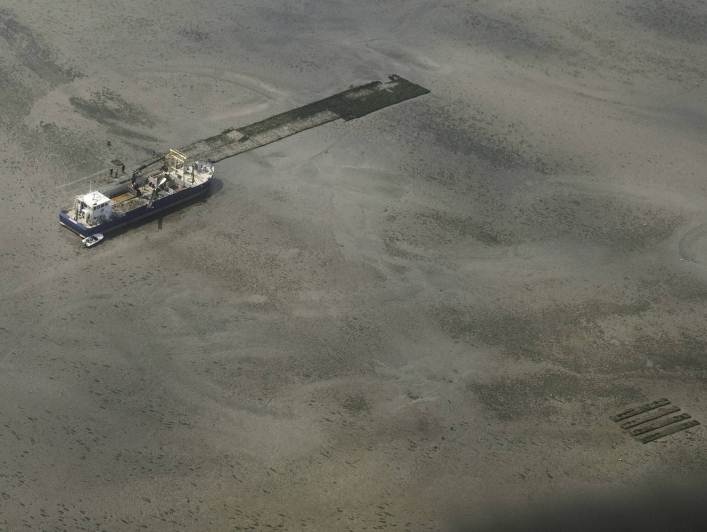Initiation
The construction of a storm-surge barrier and a number of closure dams has led to severe erosion of the tidal flats in this tidal basin. The objective of the project was to test artificial shellfish reefs in the intertidal zone in front of mudflats or salt marshes as a cost-effective and sustainable measure to protect intertidal habitats in the Eastern Scheldt (SW Netherlands).

Effecting waves by structures or vegetation 
Construction of a storm-surge barrier
Project Background
The Ecosystem Engineers (Dutch: Biobouwers) project of the Rijkswaterstaat’s WINN research programme (2006 – 2008) was the first project in the Netherlands in which the concept of shellfish reefs for shore protection was explored. The “Biobouwers project’ was executed by Deltares, NIOO-CEME (now NIOZ) and IMARES. Within the Building with Nature program, this concept was further investigated and large-scale experimental reefs have been built and are now being monitored and evaluated. An artificial ecosystem engineer (in this case a shellfish reef) is considered successful if it becomes self-sustaining (i.e. living and persistent) and reduces erosion of the tidal flat it is supposed to protect (i.e. stabilizing element).
Oyster reefs
The main goal of the project is to maintain intertidal sandy shoals, mudflats and salt marshes by utilizing ecosystem engineers in the form of oyster reefs. Their most important functions are:
- sustainable and cost-effective protection of intertidal areas against erosion,
- reduction of hydraulic forces by 1) dissipating wave energy and 2) increasing sediment deposition and reducing erosion,
- enhancing biodiversity, biomass, productivity and functioning of the ecosystem.
Ecosystem engineers (Jones et al., 1994) are organisms that modify their abiotic environment via their own biological activity and their physical structure. They are considered an important factor in the functioning of estuarine and marine ecosystems. Especially in the intertidal and shallow subtidal zone of estuaries and coasts, several ecosystem engineering species are present that form a three-dimensional structure on an otherwise bare soft-sediment bed. Examples of such ecosystem engineers are mangroves, salt marshes, sea grass beds and shellfish reefs. As the structure of these organisms can considerably decrease hydraulic forces such as wave action, it can be used to create protective barriers in front of dikes (Borsje, van Wesenbeeck et al. 2011). The structure of a shellfish reef is such that it will dissipate wave action rather than reflect it. Building with Nature adopted the concept of using ecosystem engineers as a way of solving shore erosion problems.
Oysters are ecosystem engineers that form reefs. These reefs form a conspicuous habitat that can influence tidal flow and wave action within estuaries. Oyster reefs thereby modify patterns of sediment deposition, consolidation, and stabilization. Additionally, these filter feeders can generate an extra flux of fine sediments to the intertidal habitat through excretion of faeces and pseudo-faeces (i.e. bio-deposition). After placement of a substrate of dead oyster shells, ideal for oyster larvae to settle, natural processes should further stimulate living reef formation in order achieve long-term sustainability (Powers, Peterson et al. 2009). The newly formed reef also provides habitat to a diverse species community (Scyphers, Powers et al. 2011). When successful, the initial substrate may therefore evolve into an economically and ecologically advantageous object full of life, acting as an adaptive coastal defense mechanism. The Building with Nature program therefore studies reef-building ecosystem engineers and their potential to consolidate and stabilize eroding tidal flats in the Eastern Scheldt.
